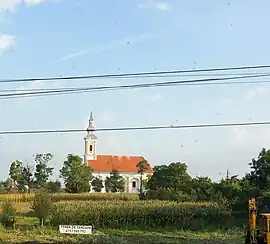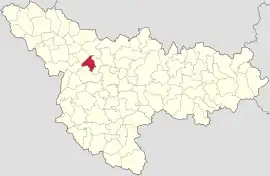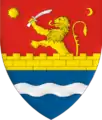Becicherecu Mic | |
|---|---|
 Serbian church in Becicherecu Mic | |
 Coat of arms | |
 Location in Timiș County | |
 Becicherecu Mic Location in Romania | |
| Coordinates: 45°50′N 21°3′E / 45.833°N 21.050°E | |
| Country | Romania |
| County | Timiș |
| Government | |
| • Mayor (2020–2024) | Raimond Rusu[1] (PSD) |
| Area | 46.65 km2 (18.01 sq mi) |
| Population (2021-12-01)[3] | 2,875 |
| • Density | 62/km2 (160/sq mi) |
| Time zone | EET/EEST (UTC+2/+3) |
| Postal code | 307040 |
| Vehicle reg. | TM |
| Website | www |
Becicherecu Mic (Hungarian: Kisbecskerek; German: Fischdorf or Kleinbetschkerek; Serbian: Мали Бечкерек, romanized: Mali Bečkerek) is a commune in Timiș County, Romania. It is composed of a single village, Becicherecu Mic. It also included Dudeștii Noi until 2004, when it was split off to form a separate commune. Its name means "Small Becicherec", as opposed to the "Great Becicherec" (Becicherecu Mare in Romanian), located in Serbia and renamed Zrenjanin in 1946.
Location
Becicherecu Mic is located 17 km (11 mi) northwest of Timișoara, on the national road DN6 Timișoara–Sânnicolau Mare–Cenad. It is also connected to the Timișoara–Cenad railway, which passes to the south, with the Pescărețul Mic station.
It borders Dudeștii Noi to the east, Hodoni to the north, Săcălaz to the southeast, Beregsău Mare to the south, Iecea Mică and Iecea Mare to the west and Biled to the northwest.[4]
History
Becicherecu Mic is mentioned as early as 1232 by the name terra Potkerequ.[5] A hundred years later, in 1334, the parish of Pechkereky pays the Vatican the "papal tithe", a grant from believers to support armed action against pagans.[4] During the Hungarian occupation, in 1462, the village is given to the Hagymásy family from Beregsău.[4] During the Turkish occupation (1552–1716), the name of the settlement would have been Crucea ("cross"), the hearth of the village being probably located on the Cross Hill.[4] After the reconquest of Banat by the Habsburg Empire, in 1717, the imperial administration records the settlement with the name Peschered, in Romanian Pescăreț ("pond with fish").[4] In 1723, in County Mercy's Karte des Temeswarer Banates (see online), the settlement appears for the first time under the name Becicherecu Mic. Its origin comes by rhotacism from the proper noun Pechereky, the name of a landowner.[4] First German settlers arrive here in 1727.[6] In 1748, 24 Romanian families brought from Transylvania were also colonized here.[6] Between 1920 and 1925, the village was named Țichindeal, after scholar Dimitrie Țichindeal, born here in 1775.[6]
Demographics
Becicherecu Mic had a population of 2,853 inhabitants at the 2011 census, up 18% from the 2002 census. Most inhabitants are Romanians (83.49%), larger minorities being represented by Roma (2.8%), Serbs (1.79%), Hungarians (1.51%), Ukrainians (1.4%) and Germans (1.16%). For 7.43% of the population, ethnicity is unknown.[7] The village was previously divided into four parts, although in recent decades the inhabitants have mixed: the "German bend" – towards the railway station, the "Serbian bend" – practically in the center of the village, the "Romanian bend" – around the Romanian church and the "Gypsy outskirts" or Chertiz, a group of specific houses, along with Serbs and Romanians.[4] At the end of World War II many of the German inhabitants left the village because of Soviet occupation. The inhabitants traveled through Yugoslavia and Hungary for about seven weeks to get to Austria on 1 November 1944. The inhabitants were then assigned families to stay with. By religion, most inhabitants are Orthodox (76.41%), but there are also minorities of Roman Catholics (5.71%), Pentecostals (5.64%), Baptists (1.37%) and Serbian Orthodox (1.23%). For 7.85% of the population, religious affiliation is unknown.[8]
| Census[9] | Ethnic composition | ||||||
|---|---|---|---|---|---|---|---|
| Year | Population | Romanians | Hungarians | Germans | Roma | Ukrainians | Serbs |
| 1880 | 3,379 | 428 | 21 | 2,395 | – | – | 498 |
| 1890 | 3,687 | 403 | 25 | 2,651 | – | – | 562 |
| 1900 | 3,738 | 422 | 40 | 2,659 | – | – | 557 |
| 1910 | 3,666 | 421 | 95 | 2,531 | – | – | 546 |
| 1920 | 3,642 | 382 | 70 | 2,533 | – | – | – |
| 1930 | 3,318 | 431 | 35 | 2,294 | 83 | – | 461 |
| 1941 | 3,098 | 436 | 20 | 2,142 | – | – | – |
| 1956 | 2,564 | – | – | – | – | – | – |
| 1966 | 2,693 | 1,544 | 12 | 734 | 69 | 68 | 250 |
| 1977 | 2,774 | 1,741 | 18 | 619 | 107 | 63 | 208 |
| 1992 | 2,316 | 1,913 | 26 | 94 | 98 | 53 | 125 |
| 2002 | 2,417 | 2,062 | 31 | 48 | 132 | 74 | 63 |
| 2011 | 2,853 | 2,382 | 43 | 33 | 80 | 40 | 51 |
Economy
The economic activity is a consistent one, supported at local level by 223 firms active in fields such as agriculture, trade, production, software, construction and iron processing, among others.[4]
The agricultural area of the commune consists of 3,464 ha (8,560 acres) of arable land on which grains are grown: wheat, maize, barley, two-rowed barley, sunflower and rapeseed; 2 ha (4.9 acres) of orchards with fruit trees and pasture that covers an area of 418 ha (1,030 acres).[4]
Notable people
- Dimitrie Țichindeal (1775–1818), priest, teacher and fabulist
- Aurel Șunda (b. 1957), footballer and manager
References
- ↑ "Results of the 2020 local elections". Central Electoral Bureau. Retrieved 16 June 2021.
- ↑ "Primăria Becicherecu Mic". Ghidul Primăriilor.
- ↑ "Populaţia rezidentă după grupa de vârstă, pe județe și municipii, orașe, comune, la 1 decembrie 2021" (XLS). National Institute of Statistics.
- 1 2 3 4 5 6 7 8 9 "Strategia de dezvoltare a comunei Becicherecu Mic" (PDF). Primăria comunei Becicherecu Mic. 2015.
- ↑ Szabó, M. Attila (2003). Erdély, Bánság és Partium történeti és közigazgatási helységnévtára. Miercurea Ciuc: Pro-Print Kiadó.
- 1 2 3 "Fișa Primăriei comunei Becicherecu Mic pe anul 2013". Consiliul Județean Timiș.
- 1 2 "Tab8. Populația stabilă după etnie – județe, municipii, orașe, comune". Institutul Național de Statistică. Archived from the original on 18 January 2016. Retrieved 5 September 2021.
- 1 2 "Tab13. Populația stabilă după religie – județe, municipii, orașe, comune". Institutul Național de Statistică. Archived from the original on 7 August 2020. Retrieved 5 September 2021.
- ↑ Varga, E. Árpád. "Temes megye településeinek etnikai (anyanyelvi/nemzetiségi) adatai 1880-2002" (PDF). Archived from the original (PDF) on 10 June 2007. Retrieved 10 September 2021.
